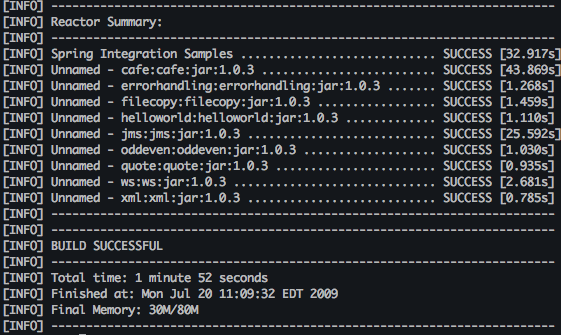Get ahead
VMware offers training and certification to turbo-charge your progress.
Learn moreSpring Integration 1.0.3 is now available. You can find links to the download, reference manual, and more at the Spring Integration home. This release includes quite a few changes, but in this blog, I'm going to focus on one in particular. Starting with this version, the samples are fully self-contained and Maven-enabled. That means you can download the distribution, go into the 'samples' directory, run 'mvn install' and then import the projects into a Maven-aware Eclipse instance, such as the SpringSource Tool Suite. Here's the step-by-step breakdown...

 Either accept all or choose the individual sample(s) that you want to import, and after a few moments of workspace building, you should be ready to run.*
Either accept all or choose the individual sample(s) that you want to import, and after a few moments of workspace building, you should be ready to run.**NOTE: if you import the 'osgi-inbound' project, you will see some errors on that particular project (but you should not see any errors on the other projects after the workspace build completes). Those errors would be resolved after configuring the runtime and the bundle repository. If you would like to work through the OSGi samples, refer to the dedicated chapter in the Reference Manual. Also, we will be posting a blog that goes into detail on those projects within a few days.
Each of the samples has a main method within a "Demo" class (except for 'osgi-inbound' and 'osgi-outbound' which are meant to be deployed within an OSGi environment - to be covered in that upcoming blog post). For example, the 'helloworld' project has 'HelloWorldDemo'. In the javadoc of each demo class, you will find a brief overview of features showcased in that individual sample.
For those familiar with Enterprise Integration Patterns, here is an overview of some of the patterns that are represented in each sample*:
| Pattern / Sample | Event Driven Consumer | Polling Consumer | Message Filter | Message Translator | Content Based Router | Splitter | Aggregator | Channel Adapter | Messaging Gateway | Service Activator | Request/Reply |
| cafe | X | X | X | X | X | X | X | X | |||
| filecopy | X | X | X | X | |||||||
| errorhandling | X | X | X | X | |||||||
| helloworld | X | X | |||||||||
| jms | X | X | X | X | X | ||||||
| oddeven | X | X | X | X | X | ||||||
| quote | X | X | X | ||||||||
| ws | X | X | X | X | |||||||
| xml | X | X | X | X | X | X |
*NOTE: All of the samples feature certain common patterns that are essential to the underlying Spring Integration core:
For more detailed information, check out the Samples chapter of the Reference Manual and the README file located directly in the "samples" directory of the main distribution. Also, stay tuned for another blog covering the new OSGi based samples added in Spring Integration 1.0.3. That should be posted within a few days.
Last but not least, be sure to check out the "POJO Messaging" sample from the Spring BlazeDS project (see the build and run instructions in the Spring BlazeDS Reference Manual). That demonstrates Flex Producer and Consumer elements whose "destinations" are backed by Spring Integration Message Channels.